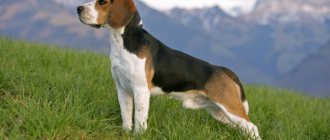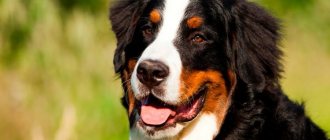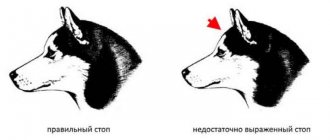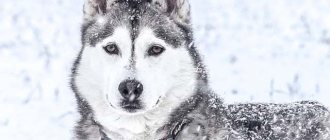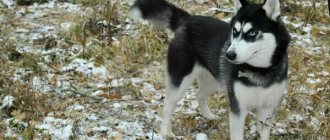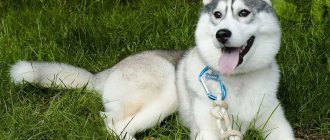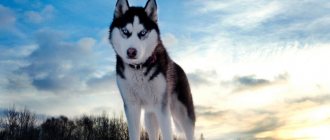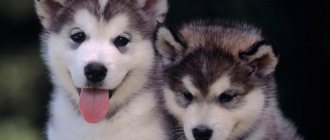The Siberian Husky is an incredibly beautiful breed that has earned the recognition of many dog lovers. Let's take a closer look at who the Siberian Husky is, the description and characteristics of the breed. When purchasing this pet, it is important to consider its characteristics. You should not get it for protection and hunting. The dog is very active, which is important to pay attention to.
This amazing breed is considered one of the oldest. It is still unknown how the Eskimos were able to train such freedom-loving animals. They bear an incredible resemblance to wolves. The dedication and hard work of these dogs was demonstrated by the famous dog Balto. He brought a team with anti-diphtheria serum in a snowstorm, thanks to which the whole city was saved from the epidemic.
Brief characteristics of the breed Amenable to training:
Gets along with animals:
Dirt in the apartment:
Puppy price:
Immunity and health:
Attachment to the owner:
Brief historical background
Siberian Huskies are representatives of an ancient breed of dogs dating back to the distant past. The Eskimo peoples who used dogs as labor and sled hounds were popularly called “Eskies”, which is where the pronunciation of the name Husky came from.
Purebred dogs lived for a long time with the people on the Arctic coast and did not wander, like many in those days. They were in dire need of sled dogs that were hardy and strong, and that’s what the Siberian hound became for them.
Also popular in Alaska, where several puppies ended up, they moved to the United States and Canada, where the yet unrecognized breed of Alaskan Huskies was bred.
- All Husky dogs are beautiful and hardy animals, with an extraordinary appearance and an equally bright character.
The first recognized standard for them was adopted in America back in 1934. Regardless of its geographical origin, the officially accepted standard is set in the USA. This is not just a dog, but first of all a hound dog, a working dog, when making such a friend, remember this. They are incredibly resilient and active, as well as very emotional.
How do huskies treat children?
The pet will not have problems in a family with children. This breed was developed by Eskimos, for whom the birth of a baby is a significant event due to weather conditions. Their dogs lived on the street, but when a child was born, people called them into their home. They lay down around the newborn to keep him warm.
The Eskimos trusted them with the most valuable things, so now huskies love children. But you should take into account the character traits of a particular dog.
Video: description and characteristics of the Siberian Husky breed
Distinctive features
Based on external data and performance characteristics, many people confuse Malamutes, Alaskans and Siberian representatives with each other. Despite the obvious similarity and kinship, they actually have clear differences.
Differences from Malamute
Dogs of this breed can really be confused if you don’t know something important - malamutes are much larger than huskies, with heavier bones, and taller. By nature he is calmer, more reasonable, more serious. They are united by working qualities: endurance, love of work.
The Malamute's coat is coarser and a little longer, and representatives of the breed also do not have such a wide range of colors in the color of the coat and eyes; according to the standard, the color of the iris is brown.
Huskies have a more cocky and emotional character, they are louder than their brothers, bark more often and can serenade your neighbors. The very description of the breed makes it clear the difference between the dogs almost immediately; the standard clearly shows a clear difference.
Alaskan Husky
The Alaskan can be classified as a Husky variety, they are not officially recognized by the FCI and are currently the most expensive mixed breed. They are indeed relatives of the Malamute, the Siberian Husky, but also the Border Collie and even the German Shepherd, as well as the Iranian Setter and, according to data from simple northern yard dogs.
The main feature is that despite such an admixture, the dog has collected in itself simply exceptional qualities of a hound dog. He is hardy, strong and devoted to his owner, an interesting breed. In appearance it is significantly different from northern dogs, just look at the photo. There is no official standard.
Main settings
For any breed, there are a number of characteristics that must be observed by breeders when breeding the breed in order to maintain its purity.
Color: its types and permissible deviations
Types of colors
The classic coat color for huskies is a combination of black, gray or brown with white.
A common occurrence is a black or white mask around the eyes and two vertical stripes on the forehead near the nose.
White pure huskies appear quite rarely,
More often it is just black.
Rarely found brown without impurities and brown-white color, fawn, brown, spotted (
pibold), as well as simply white and black.
Albinos
Albinos are present in any breed. As a result of a gene mutation, such individuals lack melanin, which leads to disturbances in the color of the skin, eyes and coat. However, not every snow-white husky is an albino: for representatives of this species, such a color is rare, but not a violation.
With partial albinism, some parts of the body may be pigmented, and the eyes may have a blue or natural color; with complete albinism, the color is completely devoid of pigment, and the eye color is red or pink.
Muzzle color
Mask
The color of the muzzle is combined with the rest of the color,
there may be markings and patterns, such as a double vertical stripe on the forehead.
Glasses
Typically there are black or white circles
.
Eye color in purebred huskies
The eyes of purebred animals can be blue, brown, amber, olive, different in color and even differently colored.
.
Wool length
Standard
The coat should be thick, short, and not bristly.
The undercoat is soft and absent during shedding. A coat that is too long, harsh or soft is considered a fault.
IMPORTANT!
It is allowed to trim Huskies only on the sides and between the toes, otherwise the animal will be disqualified from competitions.
Lengths
There are mixed opinions regarding such dogs: some consider long hair a feature as a result of crossing, others consider it a deviation from the standard
.
At an exhibition, such a fact is a disadvantage, but not a reason for disqualification
. These individuals are no different from other representatives of the breed in any way and do not require special care.
Main parameters: weight and height
Dogs that meet these parameters are allowed to participate in exhibitions. The pet's weight should be:
- male: 19.5–30 kg;
- female: 14–25 kg.
The height at the withers is:
- male: 51.5–62 cm;
- female: 49–58 cm.
Neck circumference
The neck circumference of an adult dog ranges from 43 to 51 cm.
IMPORTANT!
When standing, the neck should be raised, correctly curved, of sufficient length, and extended during movement. There should be no deviations from these characteristics.
Tail
Tail with even feathering, medium length fur,
the base begins below the top line, reminiscent of a fox. In a normal state, straightened and lowered, in a tense state it rises above the back, crescent-shaped.
Paws
The paws are parallel to each other, straight, the distance between them is moderately wide.
Pasterns slightly sloping. The dog is itching with its dewclaws. The elbows are not set too wide. Hips are powerful. When running, the paws do not turn out.
IMPORTANT!
To avoid injury, experienced dog breeders use special shoes for their pets. Sometimes, for this purpose, the dewclaws are removed in advance.
Other characteristics
In accordance with the standard, the Husky's head is not coarse or, conversely, not too light and refined.
Shoulders: oblique scapula, straight, excessively loose shoulder is a deviation. The chest is deep and powerful.
The running is easy.
Clumsiness, crossing paws, shortened strides, and skidding of the rear part of the body are not encouraged.
Reference.
Lifespan: 11–16 years.
Having carefully read all the standards and characteristics, the future owner will be able to make the right choice. To participate in exhibitions or breeding, it is necessary to select puppies that best suit the parameters and have a good pedigree.
In recent decades, huskies have begun to gain enormous popularity. They are kept in apartments, shown at exhibitions, and their extraordinary beauty is admired. But in fact, such a bright color and blue eyes appeared relatively recently and were created purely for exhibitions. Modern huskies are descendants of the sled dogs of the Far East, or more precisely, Eskimo huskies.
The word “husky” can be interpreted as a corruption of “Eski”, which is what the Eskimos used to be called. Huskies come from the Far East, where they actively hunted and fished, always with the help and obligatory participation of dogs. Usually the owner kept at least nine dogs - this is exactly the number needed for a dog harness.
The development of dog breeding in Siberia and the popularization of sled dogs are associated with the beginning of the search for “soft gold,” the so-called tax collected from the local population. To deliver valuable cargo, capacious sleds and, accordingly, more dogs were required. The Russians hired some of the locals to help them and bought the dogs from them. The introduction of the breed to America was associated with the beginning of the gold rush in Alaska. Fur traders brought strong and hardy dogs from Siberia, small in size but capable of great speed. And to distinguish it from Eskimo dogs, the breed was named Siberian Huskies.
In the 20th century, already in Soviet Russia, there was a tendency to unite breeds of sled dogs: the Chukchi, Sakhalin, and Far Eastern sled dogs, which until that moment were considered different breeds, were united together. Gradually, machine technology replaced traditional dog sleds, and the breeding of sled dogs came to naught.
The pure breed of Siberian Huskies has been preserved thanks to sled races held in Alaska. The endurance, intelligence and devotion of good huskies were appreciated by breeders. The development of sled sport required improving the qualities of the breed. Thus began the period of mixing blood with local sled dogs, hounds and cops. The resulting mestizos have surpassed pure Siberian Huskies, but are not yet recognized as a separate breed, although among racers they have received the name “Alaskan Huskies.”
As you can see, modern huskies have moved far away from their ancestors. Nevertheless, it cannot be said that interest in the breed rests purely on beauty. These blue-eyed dogs are unusually smart, have a good disposition, and get along well with children. Siberian Huskies are sled dogs, this is their main hereditary factor, they need serious physical activity and are always ready to work side by side with a person!
Purpose of the breed
One can definitely say about the husky that the dog is designed specifically for work; it was originally bred to transport loads in a sled, and has excellent endurance and excellent performance. It follows from this that representatives must receive sufficient physical activity, and not just sit on the couch.
- Keeping an animal locked up or bringing it in is prohibited. Their endurance is really serious; they are able to run in a harness all day long, without stopping to rest.
Is it possible to hunt with a Siberian friend?
The breed standard is registered as a “sled dog,” but we know that the dog has wolves in its ancestors. And as practice shows, they have a well-developed hunter’s instinct, they have good instincts and the necessary passion.
If you use skills from early childhood, you can raise a worthy hunter.
Dmitry Kuznetsov – Husky
As a student, Dmitry Kuznetsov lived in the legendary “DAS dorm”, sharing a room with three neighbors. The hostel became his home for five years; he went to his mother for just a couple of weeks a year. The rest of the time, especially during the holidays, was devoted to work and creativity. Enjoying his solitude, he resumed his rapping lessons. It was within the walls of the dorm room that he recorded his debut album, “Sbch zzn.” Husky - Black and Black After graduating from Moscow State University, Dmitry Kuznetsov did not go to work in his specialty. The rapper Husky, writer and performer was born. Husky says that he was prompted to return to music by the events on Bolotnaya Square - then, during protests against the State Duma elections and the subsequent presidential elections, many opposition politicians, including Alexei Navalny, and ordinary people who decided to peacefully express their protest were arrested.
Photo from Husky's Instagram
On October 7, 2011, he presented to the public his debut video for the song “Seventh of October.” The video was dedicated to Vladimir Putin’s birthday and hinted at the rotten essence of the Russian government elite. Husky - October 7 During the development of his career, the rapper met the writer Zakhar Prilepin. He read his books, got inspired and sent a couple of his texts by email. Later, Husky’s voice could be heard in the chorus of the composition “It’s Time to Get Out” by Zakhar Prilepin and rapper Rich.
Cover of Husky's first album
At first, he only wrote lyrics and rapped, but later he developed a passion for the musical component of songs and sound special effects. The first result was the video “Black and Black,” in which the rapper first appeared on camera. The video was highly praised by authoritative performers like Oksimiron and Karandash, calling Husky “the reincarnation of Yesenin in his gopnik neighbor.”
On April 1, 2021, Husky fans were able to evaluate the rapper’s new album “Favorite Songs of (Imaginary) People.” The album includes 13 compositions, some of which have already circulated on the Internet. “Everything that happens to me, I poured it out there... This is the most important thing I have done in my life,” Husky commented on his new album.
Husky on the set of "12 Evil Spectators"
Two weeks later, Husky appeared on MTV's 12 Angry Spectators.
Character of the breed
Even husky puppies from a very young age are able to show their leadership qualities. All you need to know about your pet is that he is stubborn, emotional and attached to his owner.
- Naturally intelligent, capable of making independent decisions, even without a person. Friendly, not aggressive, treats children well. Loves communication; it is extremely important for a pet to receive warmth and attention from a person.
It is difficult to endure loneliness, and can howl and whine while the owner is not at home. He will definitely chew and gut something while he is alone, the neighbors will know for sure that you are not at home. It is advisable to take your pet for a walk before leaving, give it the opportunity to run and play.
She sincerely loves a person, has a hard time withstanding swearing, can get offended and sit in the corner for a long time without leaving. Prone to dramatic mood swings, homesick for family, it is not recommended to change owners.
In a relationship with an animal, you will need to show perseverance and understanding, each dog is individual, some traits of its character are more pronounced, others less so. Each dog has its own character, just like any other creature.
Character and habits of Siberian Huskies
Huskies are not only endowed with a lively mind, they are characterized by friendliness and imperturbable calm. The animals' ancestors, who lived in the harsh Far North, passed on many habits and temperamental traits to modern dogs. Do not forget that huskies are sled dogs, so their activity and mobility are in full swing, they need constant physical activity.
Interesting fact: This dog is not suitable for hunting; it has instinct, but having caught prey, it will not give it to its owner. This is how it has been since time immemorial: animals were fed only in winter; at other times of the year, the husky fed itself. Huskies are also not used as guards; they have absolutely no aggression and are calm towards strangers.
The thing is that in the north dogs always lived in whole packs, so their guard instinct was zero. Huskies have first-class intelligence, they are very prone to independent (unauthorized) and very unusual decisions, which makes their training very difficult, which is why they are not service dogs either.
Despite everything, a husky can become the most reliable and invaluable friend, especially he will fit perfectly into a large family. Of course, the dog singles out only one owner, but he loves and shows tenderness to all members of the household, especially to children, with whom he likes to play pranks. Huskies have an extraordinary trait, namely, a tendency to escape.
Hooks and latches are not significant obstacles for them; the dog is able to dig a hole that goes under the fence, and can even jump over it. Such tricks are not always typical for dogs, but the owner needs to keep this in mind.
Training and education
Husky puppies need early socialization. Starting from 2 months of age, when the baby arrives at a new home, you will need to begin accustoming him to a collar and leash. As soon as all the activities are done, start going out and actively exploring new places.
- The sooner he gets used to loud sounds and noise, the better. Allow communication with strangers and other animals. Walk past busy streets; the more often your pet does new things, the faster it will get used to the world.
- At 3 – 4 months you can start learning commands, it will take a lot of patience. Start with the simplest ones, gradually increasing complexity and time. Be sure to remember about encouragement. When raising a dog, do not shout, do not offend or punish, and refrain from physical influence.
- It is very important to show your baby that you are not only happy about his successes, but also not upset when he fails; they read facial expressions perfectly and have a hard time when their owner is disappointed.
- If your baby is tired or can’t understand what you want from him, take a break, switch his attention to active play with a toy, then he will quickly relieve tension and begin learning new things with renewed vigor.
One thing we can say about the Husky is that it is a highly trainable dog that listens attentively to people. You will have to find your own key for each pet, understand its behavior and main character traits.
Purebred Husky standard
Adult dog
Husky has a medium size, harmonious proportional build
- excessively strong bones or excess weight will lead to disqualification. Movements are light and free.
The ears are medium in size, well-furred, located high on the head, close to each other, erect, without tilting, triangular in shape, tips pointing upward. Lips tight fitting, pigmented. The tail is raised high, curved, evenly pubescent, similar to a fox's. The legs are strong and muscular.
The eyes are almond-shaped, slightly slanted, different and partially colored.
The head is sharply defined, wide at the top and narrowed towards the eyes, there may be patterns and markings, and raised when standing.
The muzzle is average, tapering towards the ears. The coat is dense, not coarse, thick, short, there is an undercoat. Color may vary, including combinations with stripes and markings.
Puppy
The pet's weight will depend on its age, breed type, balanced diet and living conditions.
Only significant changes can be considered deviations from the standard. At birth weighs 500–600 g.
- 1 month:
weight - about 3 kg, almost daily weight gain, tail begins to curl; - 2 months:
5.5–6.5 kg, height at withers — 27–32 cm; - 3 months:
transition to self-feeding, almost daily weight gain. Weight is 11–12 kg, height is 38–43 cm; - 4 months:
13.5–14.5 kg, 45–49 cm; - 5 months:
16.5–17 kg, 49–51 cm; - 6 months:
20.5–21.5 kg, 51–53 cm; - 7–9 months:
intensive bone growth is observed, the puppy begins to look more and more like an adult dog, weight and height are approaching the final mark - 21–25 kg, 54–59 cm; - 9–12 months:
height and weight change slightly, physique becomes harmonious.
Final formation occurs at the age of 2–3 years.
IMPORTANT!
The color of a puppy's coat may change as it ages. Husky puppies have different eye colors.
Rules of maintenance and care
Grooming is an important component in life for an animal; the more thorough and regular it is, the better it will affect its health and life expectancy. The highlights are no different from their other four-legged counterparts.
- Coat: since the dog has a luxurious fur coat, careful care of the coat will be required. It is necessary to comb 1 – 2 times a month. During the molting period - daily, with a special brush, due to the presence of abundant undercoat, you can collect an entire dog belt from your pet at a time. Regular treatment against parasites.
- Bathing: when dirty, only with the use of special shampoos. After a walk, wash the paws and wipe the fur with a damp cloth to remove dust.
- Claws: if they do not grind down on their own, then cut them off as they grow in with a nail clipper; accustom them to this procedure from puppyhood.
- Ears and eyes: treat for excess discharge. Now there are excellent care lotions that are sold in veterinary stores, use them to treat your ears and eyes.
- Teeth: to clean plaque from teeth and improve digestion, give special “sugar seeds”, which can also be purchased at veterinary departments.
- Vaccinations, vaccinations: according to schedule and age, in a timely manner. Visit the veterinarian once every half a year for a preventive examination.
Story
Friend of the heart
In a harsh climate where temperatures could drop to -60 degrees, the Chukchi knew they could rely on huskies: a team of two dozen sled dogs could cover vast distances over ice and snow - all in one day.
For humans, these dogs were not only assistants and a means of transportation, they became full members of the family: as soon as a child was born, all the huskies - and they usually lived on the street - were called into the house so that the dogs could lie down around the baby and warm him with their warmth. When the child grew a little older, dogs could protect him and keep him company in games. Often, huskies served as “warmers” for the entire family at night: this is how the local term “two dogs-night” appeared - so many animals are needed to warm the whole body.
At the end of the 19th century, it was sled dogs that played a decisive role in the fate of the Chukchi, defending the independence of this people from “tsarist Russia.” It seems incredible, but thanks to teams of Siberian huskies, the Chukchi inflicted a significant defeat on the army of invaders and achieved autonomy.
However, at the beginning of the 20th century, the breed almost died when the Soviet government that came to power decided that the Siberian Husky was too small to transport goods, and therefore useless. Huskies were not given breed status and their breeding was prohibited.
Second birth
Surprisingly, the breed survived only thanks to the interest of the Americans. These dogs even got their name from them, since “husky” is a distorted English word “eski” - Eskimo.
Several teams were exported to Alaska in 1930, and the popularity of Siberian huskies began to flourish in America. It occurred during the “gold rush” period, when the demand for sled dogs increased noticeably, because the path to the mines was long and difficult, and Siberian huskies showed themselves in all their glory.
The dogs brought from Siberia soon began to shine in all sorts of sled races, and very soon one of the representatives of the breed became a national hero in the United States. In 1925, huskies saved the city of Nome from a diphtheria epidemic when a team of dogs led by a fluffy husky named Balto, breaking through a snowstorm, brought long-awaited medicine to the city. The whole world heard about the hero dogs, and a year later a monument was erected in New York's Central Park in honor of the feat of Balto and his four-legged team.
Wild beauty
Elegant coat with a wide variety of colors, cute masks on the face, medium height, fox tail, compact figure and intelligent blue eyes - the breed has something to boast about. And if you add endurance, strength and speed, then the husky seems ideal.
But it must be said that show dogs are often different from racing dogs. Their snout is much smaller. Such individuals look prettier, but cannot participate in races. The short muzzle does not allow the inhaled frosty air to warm up well, and the dog quickly gets tired.
Curiosity and patience, a good disposition and instincts of a hunter, a thick undercoat that allows you to sleep in the snow, and the excitement of racing through the icy desert - all this has created such a multifaceted and unique breed.
These athletic dogs with a compact build and easy gait are truly beautiful in their primitive wildness. They are like tamed wolves, but a little nobler with their proud posture, erect ears and luxurious double-layered coat that allows the dogs to cope with extreme heat. Same with the cold.
Husky eyes can be brown, olive, amber, blue or even different colors.
Black, brown and gray in combination with white are considered classic. Each representative of the breed has its own special intricate mask design on its face.
The right diet
As already mentioned about huskies, they are active animals that need physical activity. Accordingly, the diet must be selected correctly and balanced.
There are two types of power:
- cooking your own food from natural products;
- dry industrial feeds;
Which type to use is up to you. We recommend using a premium line of food that is designed and formulated specifically for hounds. Many manufacturers produce food for a specific breed, which simplifies the selection.
- Adult dogs eat 2 times a day, morning and evening, after a walk. It is not recommended to overfeed or give food in excess of the norm. There is no need to combine both types of food.
- Husky puppies eat in small portions 4 - 5 times a day, by the age of 4 - 5 months 3 - 4 times, from 7 - 8 months 3 times are enough, and from 11 - 12 months they are transferred to adult food 2 times a day. Portions are small with a break of 4 - 5 hours.
Products for natural feeding
- Lean meat: chicken, beef, turkey;
- Sea fish;
- By-products: liver, heart, tripe, neck, lung;
- Dairy products: cottage cheese, kefir, cheese;
- Seasonal vegetables: zucchini, pumpkin, white cabbage, cauliflower and broccoli, cucumber, carrots, bell pepper;
- Porridge: buckwheat, rice, oatmeal;
- Raw eggs: 1 time per week;
- Fresh herbs;
- Bone meal, cartilage.
When feeding with natural products, a complex of vitamins and minerals is selected. The importance of nutrition is especially acute during the period of growth, as well as in older age; if the diet is not compiled correctly, then the dog will not receive enough of what it needs, which will affect its physical condition and health.
Rules for feeding at home
Owners must choose whether to give their dog homemade food or store-bought food. Cheap lines contain a lot of raw starch, which huskies do not tolerate well. Among producers, preference should be given to the option for animals with high activity. It contains more healthy fats and protein, which active dogs require. You can offer a wet diet of the same brand.
You can read more about the husky diet from birth to adulthood here.
If the owner prefers home-cooked food, it is important to create a balanced menu:
- Meat is the main thing in the diet. It should be at least 50%. It is better to offer beef, rabbit or turkey. Chicken sometimes provokes an allergic reaction. Pork and lamb are not suitable for feeding huskies. Meat should be given raw, previously scalded with boiling water.
- Fish should also be on the menu. It is important to ensure that your pet does not choke on a bone or become infected with parasites. You need to boil the sea fish, clean it from the bones.
- Eggs. The boiled product can be added to cereals or vegetables. Enough 1-2 pieces per week. Only the yolk is allowed raw.
- Milk products. Milk is okay for babies, but in adult dogs it causes stomach problems. They should be given cheese, cottage cheese, yogurt.
- Cereals. Oatmeal, rice, buckwheat should be on the menu every day.
- Vegetables. The exception is beans and potatoes. Can be offered raw, boiled or steamed. It is allowed to add fresh herbs.
- Vegetable oils. They benefit animals, so they should be added to porridge and vegetables. Almost any oil or fish oil will do.
In winter, for a dog living in the yard, it is necessary to increase the portion. If your pet eats homemade food, vitamin complexes are required. Your doctor will help you choose them.
Health and life expectancy
We can say about the husky that he has a strong immune system and rarely gets sick. But, like any other animal, it has a predisposition to certain diseases.
Most often they experience the following diseases:
- Dystrophic changes in the cornea of the eye;
- Oncological diseases of the testicles;
- Cataract and glaucoma of the eye;
- Dermatitis and allergies;
- Muscle diseases.
Life expectancy on average: 12 – 15 years.
Is it worth starting
Before choosing a husky puppy, it is important to decide how suitable this breed is for you, to understand whether you can provide the animal with proper care and living conditions.
- The dog is unique, characteristic, sometimes too stubborn, requiring control from a very early age. When a cute puppy enters a house, it can touch anyone, but if you miss the moment, it can turn into an outright pest.
The physical activity required for the animal is quite large; if you see a calmer and more measured lifestyle, then it is better to pay attention to a calmer pet.
No matter how beautiful the dog is, he must first receive all the necessary care, which not everyone can provide. The owner must not only have a strong character, but also be an undisputed leader.
It can also be said about huskies that they are big cunning and beggars, remember this and do not give in to the pressure. You should not feed the animal from the table; refrain from foods that are harmful to it, even if it strongly asks for it.
Pros and cons of the breed
Let's look at the advantages and disadvantages of the husky.
Advantages:
- friendly animal, loves people;
- has good health and endurance;
- gets along well with children and other dogs;
- barks a little;
- does not have an unpleasant odor.
Flaws:
- willfulness and stubbornness;
- desire to dominate;
- lack of security qualities;
- severe shedding;
- high need for physical activity.
How to choose a puppy
Newborn babies from good breeders are often already booked before they are born. The more prestigious the kennel, the more expensive the puppies are. The price depends not only on individual indicators, but also on the availability of titles of the parents, their state of health and the recognition of the nursery.
- Cost: from 30 to 70 thousand rubles.
Nowadays, the delivery system to the regions is well developed, but it is paid separately. Almost all nurseries have their own website and Facebook page, where you can find all the contacts of the breeders.
Before choosing a puppy, find out about upcoming matings, choose a kennel and breeder, and meet in person if possible. Puppies at 1 – 1.5 months are still too small to move, but at 2 – 2.5 months it’s just right. Before your baby arrives at home, prepare by purchasing everything you need:
- Bowls;
- Collar and leash;
- Toys;
- Beds;
- Feed;
- Care products.
At a young age, babies are very active, explore the world and require increased care. It is not recommended to leave him alone for a long time. You should choose based on your preferences, decide who you like best - a female or a male. Think about what color or eye color you like best.
- It is better to choose in person, then you can pay attention to how built the puppy is, how it behaves, and its manner of communication.
Find out more information about the parents, what health problems there are, how husky puppies from previous litters feel and grow. Don’t be shy to ask and find out; good breeders will be happy to share information and help with education and care at the very beginning.
